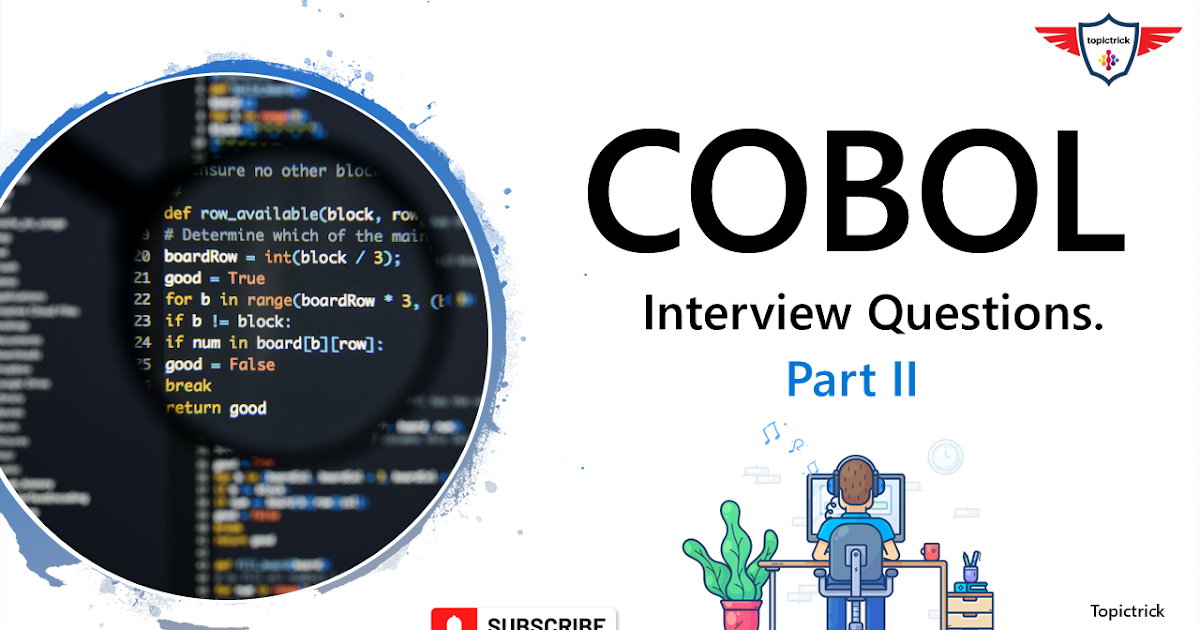COBOL Interview questions and answers for Mainframe Developers
cobol interview questions
Are you in search of COBOL Jobs? Then you are at the right place. We provide you with the complete COBOL interview Question and Answers on our page. COBOL (Common Business-Oriented Language) is a high-level programming language for business applications. It was the first popular language designed to be operating system agnostic and is still in use in many financial and business applications today. There are numerous leading companies that offer various job positions like Mainframe COBOL Developer, Delivery Module Lead, Software Engineer COBOL, Senior Engineer (mainframe), Delivery Module Lead, COBOL Consultant and many more. To clear any interview, you must prepare well for interview, so we provide a complete and tricky Interview questions on our page. To know more about interview question and answers and for various positions in COBOL visit our website Wisdomjobs.com.
cobol interview questions
Rewrite verb is used to update the records. File should be opened in I-O mode for rewrite operations. It can be used only after a successful Read operation. Rewrite verb overwrites the last record read. If 123 value is moved to a PP999 PIC clause, then what is edited value taken?
If TEST BEFORE is specified, the condition is tested at the beginning of each repeated execution of the specified PERFORM range. If TEST AFTER is specified, the condition is tested at the end of each repeated execution of the PERFORM range. The range is executed at least once in TEST AFTER. What is LOCAL-STORAGE SECTION?
Dear readers, these COBOL Interview Questions have been designed especially to get you acquainted with the nature of questions you may encounter during your interview for the subject of COBOL Programming Language. As per my experience, good interviewers hardly plan to ask any particular question during your interview. Normally questions start with some basic concept of the subject and later they continue based on further discussion and what you answer: What do you know about COBOL?
COBOL is a standard language that can be compiled and executed on various machines. It is ideally suited for business-oriented applications as it can handle huge volumes of data. It provides numerous debugging and testing tools. COBOL is a structured language; it has different divisions, so it is easy to debug. Name the divisions in a COBOL program.
.00123 edited value will be taken. P is assumed decimal scaling position which is used to specify the location of an assumed decimal point when the point is not within the number that appears in the data item. .PIC PP999 means that numeric data item is of 3 characters and there are 5 positions after the decimal point. Where can we specify OCCURS clause?
cobol interview questions
In-line PERFORM is a concept where the control will execute a block of statements from the same paragraph instead of a separate paragraph. Till the time there are no GO TOs or an exit, IN-LINE PERFORM will continue to work. The PERFORM AND END— PERFORM statements will bracket all the COBOL statements between them.
In COBOL language, NEXT STATEMENT is used to give control to the next verb following next period. Next Sentence is the collection of sentences that always ends with (.) so the control passes over to next verb following next period. When NEXT SENTENCE is coded, 1 will not be added to input count.
In 1959, the US Department of Defence formed CODASYL (Conference on Data Systems Language). CODASYL was formed with the motive to develop a computer programing language known as COBOL. It is the acronym for Common Business-Oriented Language, which is used for meeting business, administrative, finance needs. COBOL works on easy English terms and phrases so that business users understand and fulfill their data processing needs through COBOL.
ON SIZE ERROR happens in situations when the result of the arithmetic operation is larger than the fixed point field. It also happens when it is divisible by 0. Other situations that result in ON SIZE ERRORS are zero raised to zero, zero raised to some negative number or a negative number raised to a fractional power.
In binary search, the table is divided into two halves and the key values in the table will be arranged in ascending or descending order. When the table is split into two, it becomes easier to search for equal to, greater than or less than conditions until the element is found in the table. The binary search is preferred for more tables and SEARCH ALL is used for binary searching.

